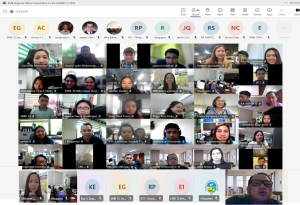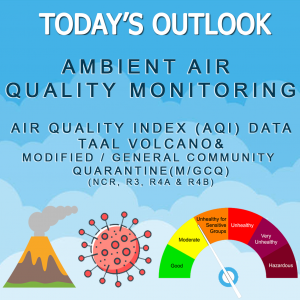
As part of the annual Clean Air Month Celebration every November, the Environmental Management Bureau (EMB) convened a Consultation Meeting, participated by technical staff from the central and regional offices to discuss key inputs for the development of the National Air Quality Status Report (NAQSR) for Calendar Year 2023.
The meeting, held on November 21, 2024, aims to gather comprehensive insights from the regional offices to ensure an accurate and well-rounded national report, reflecting air quality across the country.
Engr. Jundy T. Del Socorro, Chief of the Air Quality Management Section of EMB, emphasized the collaborative effort required to produce the report. He highlighted its significance as a tool for evaluating air quality management efforts and shaping future policies. “This report is not just a compilation of data; it is a roadmap for sustainable air quality initiatives and a benchmark for our nation’s progress in managing air pollution,” said Engr. Del Socorro. He also underscored the report’s mandate to be submitted annually to the Office of the President and Congress by March 31, 2025.
The NAQSR includes qualitative and quantitative data, encompassing air pollution levels, the performance of industries in air quality management, and initiatives from government agencies and stakeholders. The consultation aimed to ensure that each regional office’s contributions accurately reflect their challenges and achievements.
Dr. Mylene Cayetano, a consultant from the University of the Philippines Diliman- Institute of Environmental Science and Meteorology (UPD-IESM), presented the proposed
content and outline for the 2023 NAQSR. She emphasized the critical role of regional offices in providing input, guided by a detailed questionnaire designed to capture updates on regional policies, actions to reduce pollution, and best practices in managing air quality. “Your contributions are essential in creating a report that not only informs but also inspires action toward cleaner air,” Dr. Cayetano remarked.
The questionnaire solicited a wide range of information, including updates on airshed management, the designation of attainment and non-attainment areas, and regional initiatives to combat air pollution from mobile and stationary sources.
The core of the meeting focused on reviewing the inputs from EMB Regional Offices. Topics discussed included: Airshed Management: Updates on airshed governance, highlighting contributions from Airshed Governing Boards; Mobile Source Emissions: Efforts to address emissions through the Public Utility Vehicle (PUV) Modernization Program and transport planning and Best Practices: Strategies for managing air pollution, including collaboration with NGAs and LGUs on land use planning, and mitigation efforts for natural pollution sources such as volcanic eruptions and wildfires.
Focals from the regional offices also presented challenges and opportunities in their respective areas. Discussions covered the impacts of the COVID-19 pandemic on air quality, particularly the temporary reduction in emissions during lockdowns, the ongoing issues such as open burning of waste, and the need for robust photo documentation to support the report’s findings.
The consultation reinforced the importance of regional contributions in refining the NAQSR. Each input will ensure the report captures the diverse realities of air quality management across the country while addressing challenges and identifying opportunities for improvement.
The finalized NAQSR will serve as a critical resource in assessing the nation’s progress in achieving cleaner air and guiding future strategies to protect public health and the environment. ###




















